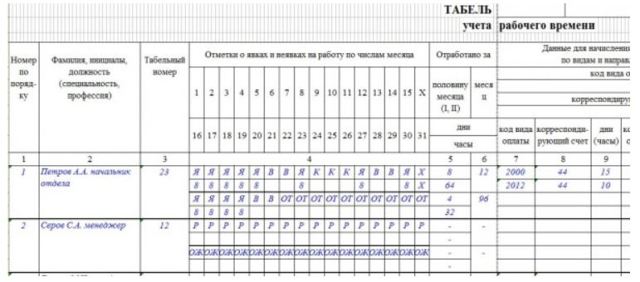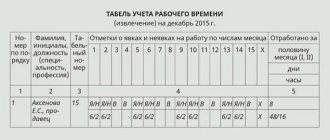How are working hours recorded?
The time sheet is maintained to perform a number of functions:
- control of working and non-working time;
- checking compliance with the work schedule by recording lateness and absences for various reasons;
- calculation of earnings for employees of the enterprise, proof of the correctness of calculations;
- obtaining information for the necessary reporting;
- the basis for imposing disciplinary sanctions on an employee due to violation of the work and rest regime.
The timesheet contains information about the days actually worked by employees.
Important! The form developed by Goskomstat is not mandatory, but is recommended for use. Employers, if necessary, have the right to develop the form themselves and use it in their work.
A unified form (T-12 or T-13) implies the reflection of information on recording visits to the enterprise for each employee. The title page of form T-12 contains information about all designation codes that are used when filling out the timesheet.
The two types of codes (alphabetic and numeric) are used equally. In addition, the local acts of an enterprise may stipulate the use of a mixed type of filling out a document, as well as other proprietary designations.
How to designate maternity leave?
Leave granted to pregnant employees in accordance with Article 255 of the Labor Code of the Russian Federation is noted in the working time sheet:
- letter designation - P,
- in digital format - 14.
Subsequent leave (to care for a child) is documented in the report card in the form of the letters OZH or the number 15.
Situations may arise when an employee, while on maternity leave, additionally carries out work on a part-time basis.
Then visits in the report card are indicated as follows: I (01) - work during the day, OJ (15) - leave to care for children under 3 years old.
The codes are marked in one cell through the “/” symbol, or an additional line is filled in in the working time sheet.
- In the report card, opposite the name of the employee who is on maternity leave, the designation (P or 14) is indicated, and the fields where the number of hours worked is recorded remain empty.
- In order to note maternity leave on the report card, you need to have a documentary justification, this is the order of the manager.
- Sample designation of maternity leave and child care in the T-13 report card:
Filling rules
When compiling a visit record sheet, you should adhere to certain standards:
- Changes regarding personnel (hiring a new employee, going on maternity leave, changing surnames) are indicated on the basis of an order;
- The timesheet is printed on a computer or filled out with blue (black) ink in one copy;
- The timesheet must be opened in the current month (no later than the 2nd or 3rd day), and closed on the last day of the month;
- Each employee is filled in on a separate line, the full last name, first name and patronymic are written down to avoid confusion with namesakes;
- The horizontal cells opposite the full name of the staffing unit contain information about hours worked;
- One column equals one calendar day;
- Attendances and absences should be noted on the report card daily, based on orders from the manager and memos;
- If errors in filling out are found in the closed report card, then an adjustment form is drawn up with the changes made.
After filling out all the fields, the responsible employee indicates his position and signs in the required fields with the explanation of his last name. The document is approved by the head of the company indicating his position. At the end, the date of compilation of the form is indicated.
HR specialists should distinguish between the types of letter codes for sick leave:
- B - a regular certificate of incapacity for work is noted;
- P - indicates sick leave for pregnancy and childbirth, including the adoption of a child;
- OZH - parental leave is noted.
The absence of an employee due to being on maternity leave is necessarily indicated in the accounting sheet with special codes: P or 14. Their list is given on the title part of the standard T-12 form.
For each maternity day until the employee goes to work, the necessary designation is given without indicating the number of hours.
Maternity leave in the time sheet: designation of maternity leave

Each organization takes into account the working time worked by staff, rest periods, and absences. This information allows you to correctly calculate employee salaries.
For this purpose, special forms of accounting documents - timesheets - are filled out. The period of maternity leave should also be noted on this form.
How are working hours recorded?
It is imperative to take into account staff working hours. As a rule, standard forms of accounting forms are used for this purpose - time sheet form T-12 and T-13.
There are two ways to count working hours:
- Mark with special designations only days other than the usual fully worked days (time off, absenteeism, vacations, sick leave, maternity days, business trips, absences for various reasons, incompletely worked days).
- Provide designations for all calendar days of the month, including weekends and regular attendance.
The organization itself chooses a convenient method for recording employee working hours.
The codes that are entered in the report card can be expressed in the form of numbers or letters.
To fill out standard forms T-12 or T-13, you need to use standard codes, which can be found on the title page of the T-12 form.
You can add your own designations to the list depending on the specifics of the company.
Filling out the timesheet is carried out on the basis of an order, in particular, to indicate the period of maternity leave, the basis is an order for leave under the BiR.
How to designate maternity leave?
An employee going on maternity leave also requires entering an alphabetic or numeric code.
A maternity leave is issued on the basis of a sick leave certificate for pregnancy and childbirth. For days of temporary disability due to illness, code B or 19 is used. However, for a certificate of incapacity for work opened in connection with pregnancy, other codes are used.
How is maternity leave designated in BiR:
- P – letter code;
- 14 – digital code.
Any designation can be used. It is entered for each day you are on maternity leave. If the duration of vacation is 140 days, you need to mark P or 14 for each, including weekends (Saturdays and Sundays).
In the part of the cell where the number of hours is noted, dashes are added for maternity days.
Upon completion of maternity leave, maternity leave begins; this maternity period is designated as follows:
- OZH – letter code;
- 15 – digital code.
Read about the designation of maternity leave here.
If a worker wishes to interrupt her maternity leave early and go back to work, then from the moment she leaves, codes I or 01 are entered on the timesheet for attendance, B for days off.
If a maternity leaver goes on part-time work while on maternity leave, then in the cells of the working time sheet two designations are entered through a fraction: the first will indicate reporting to work, the second will indicate being on maternity leave. For example, the marks could be: I/OZH or 01/15. The cell below indicates the number of hours worked.
When combining two codes in a report card, it is also possible to add an additional line.
Example notation
- Below is an example of filling out a time sheet when an employee goes first on annual paid leave, and then immediately on maternity leave.
- Days are marked with letters.

conclusions
The period of maternity leave must be recorded in the report card. For maternity days, you need to enter an alphanumeric code: 14 or P for sick leave according to BiR, 15 or OZH for maternity leave.
If an employee goes to work part-time while on maternity leave, then two designations are entered through a fraction.
Vacations, sick leave - what to do with them?
Vacation, business trip, simple or temporary disability continues or ends regardless of non-working days, based on orders from the manager or a doctor’s note on sick leave.
If on the effective date of the Presidential Decrees the employee was on vacation, a business trip, downtime, or sick, his status does not change. On the time sheet, you continue to put the appropriate code, for example, OT, K, B, NP, etc.
If an employee is on vacation from March 30 to April 30, then the vacation for these days is not extended. At the request of the employee, the employer has the right to provide leave for this period. The transfer of previously planned work to this period is carried out by mutual agreement of the employer and employee.
Designations and codes in the time sheet
The report card can use alphabetic or numeric codes to indicate a particular event, for example, attendance at work has the letter I or 01 in digital expression, absenteeism - PR or 24, additional days off without pay - NV or 28.
You can find the required code using the table.
Timesheet codes (2020) - a complete list of alphabetic and numeric characters - are contained on the first page of Form T-12.
| Code | ||
| alphabetic | digital | |
| Duration of work during the day | I | 01 |
| Duration of work at night | N | 02 |
| Duration of work on weekends and non-working holidays | RV | 03 |
| Overtime duration | WITH | 04 |
| Duration of work on a rotational basis | VM | 05 |
| Business trip | TO | 06 |
| Advanced training without work | PC | 07 |
| Advanced training with a break from work in another area | PM | 08 |
| Annual basic paid leave | FROM | 09 |
| Annual additional paid leave | OD | 10 |
| Additional leave in connection with training while maintaining average earnings for employees combining work with training | U | 11 |
| Reduced working hours for on-the-job trainees with partial pay retention | UV | 12 |
| Additional leave in connection with training without pay | UD | 13 |
| Maternity leave (leave in connection with the adoption of a newborn child) | R | 14 |
| Parental leave until the child reaches the age of three | coolant | 15 |
| Unpaid leave granted to an employee with the permission of the employer | BEFORE | 16 |
| Leave without pay under the conditions provided for by the current legislation of the Russian Federation | OZ | 17 |
| Additional annual leave without pay | DB | 18 |
| Temporary disability (except for cases provided for by code “T”) with the assignment of benefits in accordance with the law | B | 19 |
| Temporary disability without benefits in cases provided for by law | T | 20 |
| Reduced working hours versus normal working hours in cases provided for by law | Champions League | 21 |
| Time of forced absence in the event of dismissal, transfer to another job or suspension from work being declared illegal, with reinstatement to the previous job | PV | 22 |
| Absenteeism while performing state or public duties in accordance with the law | G | 23 |
| Absenteeism (absence from the workplace without good reason for the time established by law) | ETC | 24 |
| Duration of part-time work at the initiative of the employer in cases provided for by law | NS | 25 |
| Weekends (weekly vacation) and non-working holidays | IN | 26 |
| Additional days off (paid) | OB | 27 |
| Additional days off (without pay) | NV | 28 |
| Strike (under conditions and in the manner prescribed by law) | ZB | 29 |
| Absences for unknown reasons (until the circumstances are clarified) | NN | 30 |
| Downtime caused by the employer | RP | 31 |
| Downtime due to reasons beyond the control of the employer and employee | NP | 32 |
| Downtime due to employee fault | VP | 33 |
| Suspension from work (preclusion from work) with payment (benefits) in accordance with the law | BUT | 34 |
| Suspension from work (preclusion from work) for reasons provided for by law, without accrual of wages | NB | 35 |
| Time of suspension of work in case of delay in payment of wages | NZ | 36 |
Downtime and absenteeism
If the organization must continue to operate in April in accordance with Presidential Decrees, then employees are required to go to work. The employer must take all measures to ensure the epidemiological safety of employees, as well as organize their transportation to the place of work and back home. If an employee refuses to go to work, then he will be given absenteeism.
Downtime can be declared only in the organization that must work in April.
The employer must formalize everything in accordance with the law (Articles 157, 72.2 of the Labor Code) and has the right to pay for downtime for reasons beyond the control of the employer and employee, in the amount of at least two-thirds of the tariff rate, salary (official salary), calculated proportionally downtime.
If the downtime was declared before the adoption of presidential decrees on non-working periods, then it continues to apply.
How to properly arrange maternity leave in 2021
The term “maternity leave”, which does not exist in official legislation, usually refers to the period of absence from work associated with motherhood.
Before and after the birth of offspring, a woman receives from the state the opportunity to temporarily not fulfill her professional duties, but to devote herself to her family, without losing either her work experience or losing financial assistance.
It is useful for all working representatives of the fair sex to know how this type of leave is arranged, which most women have to encounter at least once in their lives, and often more than once. The nuances of such frequently arranged “rest” are also important for personnel service employees.
Maternity leave - comprehensive leave
The persistent jargon of “maternity leave” actually hides 2 different vacations, the only common feature of which is their connection with the birth of a child.
- Maternity leave
- Leave related to the need to care for a child up to 1.5 or three years of age.
Components of the maternity leave:
- have different bases;
- are issued separately and each in its own way;
- of various durations;
- payment differs between the employer and the state.
Rumor has united them into a common “maternity leave”, since in practice in most cases they go one after the other and have no breaks between them.
REFERENCE! Legislatively, the right to leave related to future motherhood is regulated by Art. 255-256 of the Labor Code of the Russian Federation. Special and work experience is not interrupted by a long maternity leave.
Who is entitled to maternity leave?
The Labor Code enshrines the right of any working woman to go on maternity leave, namely:
- an employee who has signed an employment contract (work experience does not matter);
- registered with the Employment Service with the official status of unemployed;
- female students studying full-time;
- a woman in military service;
- the female part of the civilian personnel of military institutions.
NOTE! Some types of paid benefits during this leave are available to everyone, and some - only to officially employed expectant mothers.
Timing is an important issue in motherhood
When establishing the duration of maternity leave and the time of leaving for it, the legislation is guided not only by the natural rhythms of childbirth, but also by the conclusions of the doctor leading the pregnant woman, which is reflected in the relevant legal acts.
Each type of leave that constitutes maternity leave has its own specific timing.
Maternity leave (Maternity leave)
In the last months leading up to childbirth, it becomes difficult for a woman, and sometimes she cannot cope with her usual work duties, and often even the journey to her place of work. The state provides her with the opportunity to be considered temporarily disabled, that is, to issue a sick leave for the prenatal and postpartum periods. The duration of these periods varies:
- before the expected birth, a woman is allowed to rest for 70 days according to the calendar;
- after childbirth, sick leave will continue for another 70 days if the birth was normal, and for 86 days in case of complicated birth situations (in particular, a cesarean section);
- if not one baby is expected to be born, but several at once, the happy mother will be allowed to rest 2 weeks earlier - the prenatal period will be 84 days;
- the parent of twins and more children after childbirth is entitled to 110 days of paid sick leave;
- The countdown of these periods begins with the issuance of a sick leave certificate at the antenatal clinic, which occurs in a normal pregnancy at 30 weeks, and in a multiple pregnancy at 28 weeks.
ATTENTION! If unexpected inconsistencies arise in the estimated dates on which the leave is based (for example, a woman gave birth prematurely, postponed the pregnancy, or the gestational age was incorrectly calculated), the leave dates remain unchanged. To extend it, you need a new sick leave and, on its basis, additional leave.
When adopting a small child (up to 3 months), a woman is also entitled to leave similar to that provided under the BiR.
Instructions for expectant mothers: how to apply for leave under BiR
- At 30 weeks (or 28, if more than 1 baby is expected), the pregnant woman receives a certificate of incapacity for work from the antenatal clinic doctor and has it certified by her supervisor.
- A pregnant employee writes an application for maternity leave to her employer in her own hand. This document must indicate the reason for future absence from work (A&W) and the terms calculated from the sick leave. It’s worth immediately adding a clause about the request to accrue the corresponding benefits, otherwise they will have to be processed separately.
- The HR department, based on the application and sick leave, issues an order to provide this type of leave. The expectant mother is completely free from labor worries from the date specified in the order.
Additionally, you need to prepare the following documents:
- copy of ID;
- a certificate from the accounting department about income for the last 2 years;
- bank account number or plastic card (for transferring benefits);
- a certificate from the housing complex stating that the woman registered before the 12-week period (an additional payment is due for early registration).
Parental leave for up to 1.5 or 3 years
Issued after the birth of the child before the expiration of postpartum vacation days: the first vacation will smoothly transition into the second.
IMPORTANT! This type of leave, unlike the first, can be issued not only to the child’s mother, but also to any person who will care for him - father, relative, guardian, the choice is up to the child’s family: it is possible if the mother has resumed working activity after the birth of the baby.
Labor guarantees for those on this leave:
- maintaining the workplace at the “pre-maternity leave” workload;
- payment of monthly “employer” compensation;
- taking into account the first 1.5 years of child care in the pension period;
- impossibility of dismissal before going to work.
FOR YOUR INFORMATION! The difference between a 1.5-year and a 3-year vacation is only in the payment of monthly benefits from the employer and the pension period. These are not different types of leave, but one, issued once, which can be completed at any convenient time before the child turns 3 years old.
Documenting
- A mother or another officially employed loved one submits a written application to her employer (it also includes requirements for the calculation of 2 monthly payments - benefits and compensation).
- Providing a birth certificate for the baby.
- If it is not the mother who arranges the leave, a certificate is needed stating that she is not using her right to maternity leave.
- Registration of the order by the HR department (the applicant receives a copy).
IMPORTANT INFORMATION! Two maternity leaves cannot be taken out at the same time.
If before the end of the maternity leave a woman is going on a second one, then the dates in the two orders should not overlap each other. In such a situation, it is financially more profitable for a woman to apply for B&R benefits than to continue to receive compensation from the employer.
Thus, it is worth writing an application for going back to work, and then for a new leave for the second pregnancy and childbirth.
For adopted children, parental leave is issued in the same manner as for relatives.









